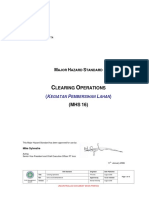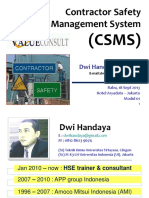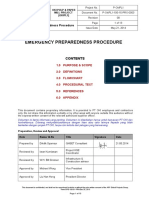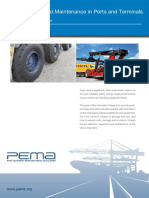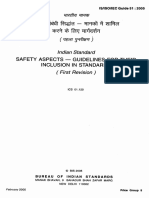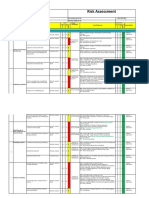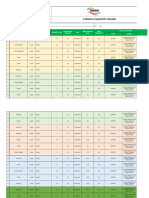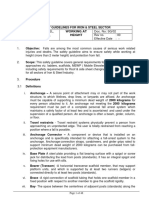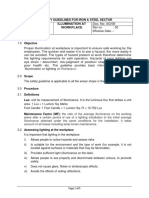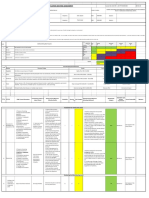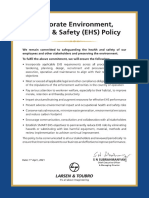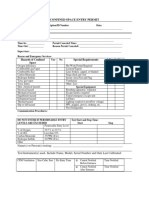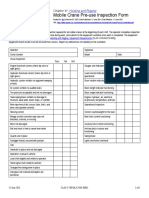Hand and Power Tool Safety
Hand and Power Tool Safety
Uploaded by
tariq1987Copyright:
Available Formats
Hand and Power Tool Safety
Hand and Power Tool Safety
Uploaded by
tariq1987Original Title
Copyright
Available Formats
Share this document
Did you find this document useful?
Is this content inappropriate?
Copyright:
Available Formats
Hand and Power Tool Safety
Hand and Power Tool Safety
Uploaded by
tariq1987Copyright:
Available Formats
HAND AND PORTABLE
POWER TOOL
SAFETY GUIDELINES
PURPOSE
The purpose of this guidance document is to promote the safe use of, and to reduce the likelihood
of injuries involving hand or power tools.
SCOPE
These requirements apply to all University departments and their employees where the use of
hand or power tools are in use or will be used. This will most notably apply to employees
involved in industrial, maintenance, construction and manual labor trade areas.
RESPONSIBILITIES
Environmental Health and Safety: EHS is responsible for reviewing hazards associated with
hand and portable power tools during annual shop inspections. The tools will be reviewed to
make sure they are in good working order, suitable for the jobs they are used for, and do not pose
a hazard to the operator. EHS is responsible for reviewing and updating the Hand & Portable
Power Tools Guidelines. EHS and supervisors can also work jointly in the development of Job
Safety Analysis for hand tools that present a unique hazard to the employee.
Supervisor and Employee: Supervisor led training is required upon employment for employees
who operate hand and portable power tools.
• Select the Right Tool for the Job: Examples of unsafe practices are: Striking
hardened faces of hand tools together (such as using a carpenter's hammer to strike
another hammer, hatchet, or metal chisel), using a file for a pry, a wrench for a
hammer, using a ‘cheater’, and pliers instead of the proper wrench.
• Keep Tools in Good Working Condition: Wrenches with cracked work jaws, screw
drivers with broken points or broken handles, hammers with loose heads, dull saws,
and extension cords or electric tools with broken plugs, improper or removed
grounding prongs, or split insulation are examples of tools in poor conditions. Tools
that have deteriorated in this manner must be taken out of service.
• Use Tools the Right Way: Screw drivers applied to objects held in the hand, knives
pulled toward the body, and failure to ground electrical equipment are common
causes of accidents.
• Place/Keep/Store Tools in a Safe & Secure Place: Many accidents have been
caused by tools falling from overhead and by knives, chisels, and other sharp tools
Hand and Power Tool Guidelines GS-91 Page 1
carried in pockets or left in tool boxes with cutting edges exposed. Tools should be
kept away from work bench edges.
The following procedures are excellent shop practices for supervisors and employees to follow
in order to promote a safe working environment where hand and portable power tools are used:
• Establish regular tool inspection procedures and provide good repair facilities to ensure
that tools will be maintained in safe condition.
• Establish a procedure for control of tools such as a check-out system at tool cribs.
• Provide proper storage facilities in the tool room and on the job.
• The employer is responsible for the safe condition of tools and equipment used by
employees, but the employees have the responsibility for properly using and maintaining
tools.
**Failure to observe safe work practices when using hand and portable power tools accounts
for most hand and power tool accidents.
Each supervisor is to make a complete check of his/her operations to determine the need for
special tools that will do the work more safely than ordinary tools. This can be completed by
developing a Job Safety Analysis which can be used to identify the hazards associated with the
job and the appropriate tools that should be used.
Special tools should be kept readily available in a centralized tool room if possible.
The tool room attendant or craft supervisor should be qualified through training and experience
to pass judgment on the condition of tools for further use. Dull or damaged tools shall not be
returned to stock.
Employees shall not continue use of damaged tools during a job if it is noticed during the job that
the tool is damaged.
Proper maintenance and repair of tools requires adequate facilities, work benches, vises, a forge
or furnace for hardening and tempering, tempering baths, safety goggles, repair tools, grinders,
and good lighting. Employees specifically trained in the care of tools should be in charge of
these facilities. If this service is not available, tools should be sent out for repairs.
CARRYING TOOLS
Employees are prohibited from carrying tools, which in any way could interfere with using both
hands freely on a ladder or while climbing on a structure. A strong bag, bucket, or similar
container is to be used to hoist tools from the ground to the job. Tools are to be returned in the
same manner. Employees should never bring tools down by hand, carry in pant/shirt pockets, or
dropped tools to the ground.
Loose tools and tools laid inappropriately cause a substantial portion of hand tool injuries.
Tools should not be left above where employees are moving or walking. This presents a falling
object hazard.
Hand and Power Tool Guidelines GS-91 Page 2
Chisels, screwdrivers, and pointed tools shall never be carried in an employee's pocket. They are
to be carried in a tool box/cart, a carrying belt (sharp/pointed end down) like those used by
electricians and steel employees, a pocket tool pouch, or in the hand with points and cutting
edges pointed away from the body.
Employees carrying tools on their shoulders should pay close attention to clearances when
turning around. Tools should also be handled so that they will not strike other employees or
pedestrians.
PERSONAL PROTECTIVE EQUIPMENT
Appropriate personal protective equipment (i.e.: safety
glasses, face shield, safety goggles, gloves, etc.) should be
worn to protect from hazards that may be encountered
while using portable power tools and hand tools. Face Shield Safety Glasses
Employees that use hand and power tools and are exposed to the hazards of falling, flying,
abrasive and splashing materials, or exposed to harmful dusts, fumes, vapors, or gases shall be
provided with the specified personal protective equipment necessary to protect them from the
hazard.
USE OF HAND TOOLS
Hand tools are non-powered, which includes axes, wrenches, screw drivers, hammers, etc. The
greatest hazards posed by hand tools results from misuse and improper maintenance.
Employee instruction/training programs shall provide detailed training in the proper use of hand
tools for the specific area of operations in which they will be working in. Attention will be given
to tool selection, tool use, and proper personal protective equipment that are required to be used
when operating the specific tool as outlined in the following sections:
Metal-Cutting Hand Tools
Chisels
• Factors determining the selection of cold chisels
are the materials to be cut, the size and shape of
the tool, and the depth of the cut to be made.
Various Metal
Cutting Chisels
• The chisel should be made heavy enough so that it
will not buckle or spring when struck.
• A chisel no larger than the material should be selected so that the blade is used rather
than the point or corner. Also, a hammer heavy enough to do the job should be used.
• Employees are required to wear safety goggles when using a chisel and should set up a
shield or screen to prevent injury to other employees from flying chips. If a shield does
not give protection to all exposed employees, then all employees in the work area are
required to wear glasses with side protection.
Hand and Power Tool Guidelines GS-91 Page 3
Tap and Die Work
• Tap and die work should be firmly mounted
in a vise.
• Only a T-handle wrench or adjustable tap
Die Tap
wrench should be used.
• When threads are being cut with a hand die,
hands and arms should be kept clear of the
sharp threads coming through the die, and
metal cuttings should be cleared away with a
brush.
Hack Saws
• Hacksaws should be adjusted in the frame to prevent
buckling and breaking, but should not be tight enough
to break off the pins that support the blade. Hacksaw
• Install blade with teeth pointing forward.
• Pressure should be applied on the forward stroke not
on the back stroke.
• If the blade is twisted or too much pressure is applied,
the blade may break and cause injury to the hands or arms of the user.
Files
Various
• Selection of the right kind of file for the job will prevent Files
injuries and lengthen the life of the file.
• The file should never be cleaned by being struck against a
vise or other metal object due to file chips becoming
possible flying debris.
• A file-cleaning card or brush should be used.
• A file is not to be hammered or used as a pry. Use of a file
in this manner frequently results in the file
File with a handle
chipping or breaking causing injury to the user.
Wood Handle File
• A file should not be made into a center punch,
chisel, or any other type of tool because the
hardened steel may fracture in use.
**All files shall be used with a
handle during use.
Hand and Power Tool Guidelines GS-91 Page 4
• A file is never to be used without a smooth, crack-free handle; if the file were to get hung
up, the tang may puncture the palm of the hand, the wrist, or other part of the body.
• Under some conditions, a clamp-on raised offset handle may be useful to give extra
clearance for the hands.
• Files are not to be used on lathe stock turning at high speed (faster than three turns per
file stroke) because the end of the file may strike the chuck, dog, or face plate and throw
the file (or metal chip) back at the operator hard enough to inflict serious injury.
Tin/Sheet Metal Snips
• Tin snips should be heavy enough to cut the
material so easily that the employee needs only
one hand on the snips and can use the other to
hold the material.
• The material is to be well supported before the
last cut is made so that cut edges do not press
against the hands.
Sheet Metal Snips
• Jaws of snips are to be kept tight and well
lubricated.
• Employees are required to wear safety goggles when trimming corners or slivers of metal
because small particles often fly with considerable force.
• Employees are also required to wear gloves when making cuts.
Cutters
• Cutters used on wire, reinforcing rods, or bolts should have ample capacity for the stock;
otherwise, the jaws may be sprung or spread.
• Chips may fly from the cutting edge
and injure the user. Wire
Bolt Cutters
• Frequently lubricate cutters. Cutter
• To keep cutting edges from becoming
nicked or chipped, cutters are not to
be used as nail pullers or pry bars.
• Cutter jaws should have the hardness
specified by the manufacturer for the particular kind of material to be cut.
Hand and Power Tool Guidelines GS-91 Page 5
• By adjustment of the bumper stop behind the jaws, cutting edges are to be set to have a
clearance of 0.003 inch when closed.
Wood Cutting Hand Tools
Edged tools are to be used so that if a slip should occur, the direction of force will be away
from the body. For efficient and safe work, edged tools are to be kept sharp and ground to
the proper angle. A dull tool does a poor job and may
stick or bind.
Wood
Wood Chisels Chisels
• Inexperienced employees shall be instructed in the
proper method of holding and using chisels. Handles
are to be free of splinters.
• The wood handle of a chisel struck by a mallet is to
be protected by a metal or leather cap to prevent it
from splitting.
• The work to be cut must be free of nails to avoid damage to the blade or cause a chip to
fly into the user's face or eye.
Saws
• Saws should be carefully selected for the
work they are to do.
• For crosscut work on green wood, a coarse
saw (4 to 5 points per inch) is to be used.
• A fine saw is better for smooth, accurate
cutting when using dry wood. Crosscut Hand Saw
• Saws are to be kept sharp and well set to
prevent binding.
Axes
• The employee is to make sure that there is a clear circle in which to swing the axe before
chopping materials.
• All vines, brush, and shrubbery within the range should be
removed, especially overhead vines that may catch or deflect
the axe.
Axe
• Axe blades are required be protected with a sheath or metal
guard wherever possible.
Hand and Power Tool Guidelines GS-91 Page 6
• When the blade cannot be guarded, it is safer to carry the axe at one's side.
• The blade on a single-edged axe shall be pointed down.
Hatchets
• Hatchets shall not be used for striking hard metal surfaces since the tempered head may
injure the user or others by flying chips.
• When using a hatchet in a crowded area, employee shall take special care to prevent
injury to themselves and other employees.
• Using a hatchet to drive nails is prohibited.
Miscellaneous Cutting Hand Tools
Scrapers, Knives, Scalpels/X-acto Knives, & Box Cutters
• Are to be used only by experienced employees.
X-acto Knife
• These tools are to be kept sharp and in good condition.
• The principal hazard in the use of knives is that hands may
slip from the handle onto the blade or that the knife may
strike the body or the free hand.
• A handle guard or a finger ring (and swivel) on the handle
eliminates these hazards and is required to be used. Box Cutter
• Employees who must carry knives with them on the job
shall keep them in sheaths or holders.
• Never carry a sheathed knife on the front part of a belt, but
carry it over the right or left hip, toward the back. This
will prevent severing a leg artery or vein in case of a fall.
• Knives should be stored safely and must never be left lying Pocket Knife
on benches or in other places such as being hidden under a
product, under scrap paper or wiping rags, or among other
tools in work boxes or drawers where they may cause hand
injuries. Safe placing and storing of knives is one of
the most important keys to knife safety.
• Supervisors must make certain that employees who
handle knives have ample room in which to work so
they are not in danger of being bumped by other
employees. Various Scrapers
• Knives are to be kept separate from other tools to
protect the cutting edge of the knife as well as to
protect the employee.
Hand and Power Tool Guidelines GS-91 Page 7
• Horseplay such as throwing knives, "fencing", trying to cut objects into smaller and
smaller pieces, and similar practices are prohibited around any knife operations.
• Supervisors shall assure that nothing is cut that requires excessive pressure on the knife.
• Knives shall not be used as a substitute for can openers, screwdrivers, or ice picks.
Torsion Tools
Open-End or Box Wrenches
• Open-end or box wrenches shall be inspected to make sure that they fit properly and that
the jaws are not sprung or cracked.
• When defective, the wrench is required to be taken out of
Open End
service until repaired.
Wrench
Socket Wrenches
• Socket wrenches are safer to use than adjustable or open-
end wrenches.
• Socket wrenches give great flexibility in hard-to-reach places. The use of special types
shall be encouraged where there is danger of injury.
Socket Wrenches
Adjustable Wrenches
• Adjustable wrenches are used for many purposes, but are
not intended to take the place of standard open-end, box
or socket wrenches.
• They are used mainly for nuts and bolts that do not fit a standard wrench.
• Pressure is always applied to the fixed jaw.
Pipe Wrenches
Adjustable
• Pipe wrenches, both straight and chain tong, shall have Wrench
sharp jaws and be kept clean to prevent slipping.
• The adjusting nut of the wrench is to be inspected
frequently, and taken out of service if cracked. A
cracked nut may break under strain, causing A piece Pipe Wrench
of pipe (also called a ‘cheater’) slipped over the
handle shall not be used to give added leverage
because this can strain a pipe wrench to the breaking
point.
Hand and Power Tool Guidelines GS-91 Page 8
• The handle of every wrench is designed to be long enough for the maximum allowable
safe pressure.
• A pipe wrench should never be used on nuts or bolts, the corners of which will break the
teeth of the wrench, making it unsafe to use on pipe and fittings, and it also damages the
nuts/bolts.
• A pipe wrench shall not be used on valves, struck with a hammer, nor used as a hammer.
Pliers
• Side-cutting pliers sometimes cause injuries when short ends of wires are cut.
• A guard over the cutting edge and the use of safety glasses will help prevent eye injuries.
• The handles of electricians' pliers are to be insulated. In addition, employees shall wear
the proper electrical rated gloves if they are to work on energized lines.
Slip Joint Pliers Long Nose Pliers
• Pliers shall not be used as a substitute with Side Cutter
for a wrench.
Special Cutters for Banding Wire/Strap
• Special cutters include those for cutting
banding wire and strap. Claw hammers
and pry bars shall not be used to snap metal banding material.
Pipe Tongs
• Employees must neither stand nor jump on the tongs nor place extensions on the handles
to obtain more leverage. Larger tongs should be used if an employee encounters either
scenario.
Screwdrivers
• The practice of using screwdrivers for punches, wedges, pinch bars, or pry-bars shall not
be allowed.
• Cross-slot (Phillips head) screwdrivers are safer than the square bit type, because they
have fewer tendencies to slip. The tip must be kept
Flat
clean and sharp, however, to permit a good grip on the Phillips
Head
head of the screw. Head
Screwdrivers
Hand and Power Tool Guidelines GS-91 Page 9
• (For use on metal surfaces)The part to be worked upon
must never be held in the hands; it should be laid on a Brass-Tipped
bench or flat surface or held in a vise. Spark
Resistant
Hammer
• No screwdriver used for electrical work shall have the Rubber Mallet
blade or rivet extending through the handle. Both blade
and handle shall be insulated except at the tip.
Shock Tools
Hammers
• A hammer is to have a securely wedged handle suited to the
type of head used. The handle shall be smooth, without
cracks or splinters, free of oil, shaped to fit the hand, and of
the specified size and length. Employees shall be warned
against using a steel hammer on hardened steel surfaces.
Instead, a soft-head hammer or one with a plastic, wood, or (For use on
metal surfaces)
rawhide head should be used. Safety goggles or safety
glasses shall be worn to protect against flying chips, nails, or
scale.
Riveting Hammers
• Riveting hammers, often used by sheet metal
employees, must have the same kind of use and care as
ball pen hammers and should be watched closely for
cracked or chipped faces.
Riveting Hammer
Carpenter's or Claw Hammers
• The faces shall be kept well dressed at all times to reduce the hazard
of flying nails while they are being started into a piece of wood.
• A checker-faced head is sometimes used to reduce this hazard.
Claw
Hammer
**When nailing is being conducted in a work area, eye protection is
advised to be used by all employees nailing and all employees working in
the same area.
Hand and Power Tool Guidelines GS-91 Page 10
Spark-Resistant Hand Tools
Around flammable substances, sparks produced by iron and steel hand tools can be a
dangerous ignition source. Where this hazard exists, spark-resistant tools made from brass,
plastic, aluminum, or wood will provide for safety.
Brass Tipped
Spark Resistant
Hammer
Brass Constructed
Tip
POWER TOOL PRECAUTIONS (OSHA 1926.302)
Power tools can be hazardous when improperly used. There are several types of power tools,
based on the power source they use: electric, pneumatic, liquid fuel, hydraulic, and powder-
actuated.
The following general precautions should be observed by power tool users:
• Never carry a tool by the cord or hose.
• Never yank the cord or the hose to disconnect it from the receptacle.
• Keep cords and hoses away from heat, oil, and sharp edges.
• Cords are required to be free of frays/cuts. If the cord is damaged, the equipment shall be
removed from service immediately.
• Disconnect tools when not in use, before servicing, and when changing accessories such
as blades, bits and cutters.
• All observers should be kept at a safe distance away from the work area.
• Secure work with clamps or a vise, freeing both hands to operate the tool.
• Avoid accidental starting. The employee should not hold a finger on the switch button
while carrying a plugged-in tool.
• Tools should be maintained with care. They should be kept sharp and clean for the best
performance. Follow instructions in the user's manual for lubricating and changing
accessories.
Hand and Power Tool Guidelines GS-91 Page 11
• Be sure to keep good footing and maintain good balance.
• The proper apparel should be worn. Loose clothing, ties, or jewelry can become caught in
moving parts.
All portable electric tools that are damaged shall be removed from use and tagged "Do Not Use”.
GUARDS (OSHA 1910.243)
Hazardous moving parts of a power tool need to be
safeguarded. For example, belts, gears, shafts, pulleys,
sprockets, spindles, drums, fly wheels, chains, or other
reciprocating, rotating, or moving parts of equipment must
be guarded if such parts are exposed to contact by
Shearing
employees. Guards, as necessary, should be provided to Mechanism
protect the operator and others from the following:
Shear Guard
• point of operation,
• in-running nip points,
• rotating parts, and
• flying chips and sparks.
Safety guards shall never be removed when a tool is being used.
*See Machine Guarding section EHS Policy (GS 90) for further machine guarding information.
Example with pictures to illustrate: A portable circular saws must be equipped with guards. An
upper guard must cover the entire blade of the saw. A retractable lower guard must cover the
teeth of the saw, except when it makes contact with the work material. The lower guard must
automatically return to the covering position when the tool is withdrawn from the work.
Hand and Power Tool Guidelines GS-91 Page 12
Fixed Upper
Guard
Guard retracts
Retractable Portable when cutting
Lower Guard Circular Saw materials.
SAFETY SWITCHES
The following tools are required to be equipped with a constant pressure switch or control that
will shut off the power when the pressure is released if they do not have a positive accessory
holding means:
• All hand-held powered circular saws having a blade diameter greater than 2
inches.
• Electric, hydraulic or pneumatic chain saws.
• Percussion tools.
**All hand-held gasoline powered chain saws shall be equipped with a constant pressure
throttle control that will shut off the power to the saw chain when the pressure is released.
The following tools are required to be equipped with a constant pressure switch or control, and
may have a lock-on control provided that turnoff can be accomplished by a single motion of the
same finger or fingers that turn it on:
• All hand-held powered drills.
• Tappers.
• Fastener drivers.
• Horizontal, vertical, and angle grinders with wheels greater than 2 inches in
diameter.
• Disc sanders with discs greater than 2 inches in diameter.
• Belt sanders, reciprocating saws, saber, scroll, and jig saws with blade shanks
greater than a nominal one-fourth inch (1/4”).
• Other similarly operating powered tools shall.
Other hand-held powered tools such as circular saws having a blade diameter greater than 2
inches, chain saws, and percussion tools without positive accessory holding means must be
equipped with a constant pressure switch that will shut off the power when the pressure is
released.
Hand and Power Tool Guidelines GS-91 Page 13
ELECTRIC TOOLS
Employees using electric tools must be aware of several dangers. The most serious of these
dangers is the possibility of electrocution.
Among the chief hazards of electric-powered tools are burns and slight shocks which can lead to
serious injuries or even heart failure. Under certain conditions, even a small amount of current
can result in fibrillation of the heart and eventual death. A shock also can cause the user to fall
off a ladder or other elevated work surface.
To protect the user from shock, tools must have a three-wire cord Grounding
Prong
with a ground prong and be grounded, double insulated, or
powered by a low-voltage isolation transformer.
Three-wire cords: These cords contain two current-carrying
conductors and a grounding conductor. One end of the
grounding conductor connects to the tool's metal housing. The
other end is grounded through a prong on the plug. Anytime an
adapter is used to accommodate a two-hole receptacle, the adapter wire must be attached to a
known ground. The third prong should never be removed from the plug.
Double insulation: This is a more convenient method. The user and the tools are protected in
two ways: by normal insulation on the wires inside, and by a housing that cannot conduct
electricity to the operator in the event of a malfunction.
The following general practices should be followed when using electric tools:
• Electric tools should be operated within their design limitations.
• Gloves and safety footwear are recommended during use of electric tools.
• When not in use, tools should be stored in a dry place.
• Electric tools should not be used in damp or wet locations.
• Work areas should be well lighted.
• Frayed cords are required to be taken out of service and replaced.
• Electric cords shall be inspected periodically and kept in good condition. Heavy-duty
plugs that clamp to the cord should be used to prevent strain on the current-carrying parts,
if the cord is accidentally pulled.
• Although no guards are available for drill bits, some protection is afforded if drill bits are
carefully chosen for the work to be done, such as being no longer than necessary to do the
work.
• Where the operator must guide the drill by hand, the drill is required to be equipped with
a sleeve that fits over the drill bit. Oversized bits shall not be ground down to fit small
electric drills; instead, an adapter should be used that will fit the large bit and provide
extra power through a speed reduction gear; however this again is an indication of
improper drill size. When drills are used, the pieces of work are to be clamped or
anchored to prevent whipping.
Hand and Power Tool Guidelines GS-91 Page 14
• Electric saws are usually well guarded by the manufacturer, but employees must be
trained to use the guard as intended. The guard should be checked frequently to be sure
that it operates freely and encloses the teeth completely when it is cutting.
• Circular saws shall not be jammed or crowded into the work. The saw is to be started
and stopped outside the work.
POWERED ABRASIVE WHEEL TOOLS
Powered abrasive grinding, cutting, polishing, and wire
buffing wheels create special safety problems because they
may throw off flying fragments.
Before an abrasive wheel is mounted, it should be
inspected closely and sound- or ring-tested to be sure that it Powered
Abrasive
is free from cracks or defects. To test, wheels should be
Wheel
tapped gently with a light non-metallic instrument. If they
sound cracked or dead, they could fly apart in operation and so must not be used. A sound and
undamaged wheel will give a clear metallic tone or "ring."
To prevent the wheel from cracking, the user should be sure it fits freely on the spindle. The
spindle nut must be tightened enough to hold the wheel in place, without distorting the flange.
Follow the manufacturer's recommendations. Care must be taken to assure that the spindle wheel
will not exceed the abrasive wheel specifications.
Due to the possibility of a wheel disintegrating (exploding) during start-up, the employee should
never stand directly in front of the wheel as it accelerates to full operating speed.
Portable grinding tools need to be equipped with safety guards to protect employees not only
from the moving wheel surface, but also from flying fragments in case of breakage.
In addition, when using a powered grinder:
• Always use eye protection.
• Turn off the power when not in use.
• Never clamp a hand-held grinder in a vise.
ABRASIVE WHEEL USE:
• Floor stand and bench mounted abrasive wheels, used for external grinding shall be
provided with safety guards (protection hoods). The maximum regular exposure of the
grinding wheel periphery and sides shall be not more than 90 degrees except that, when
work requires contact with the wheel below the horizontal plane of the spindle, the
angular exposure shall not exceed 125 degrees.
Hand and Power Tool Guidelines GS-91 Page 15
**Safety guards shall be strong enough to withstand the effect of a bursting wheel.
• Floor and bench-mounted grinders shall be provided with
work rests which are rigidly supported and readily 1/4”
adjustable. Such work rests shall be kept at a distance not
to exceed one-eighth inch (1/8”) from the surface of the Work
wheel. Rest
• The top of the guard that covers the abrasive wheel should
be no more than one-quarter inch (1/4”) from the abrasive 1/8”
wheel.
• Cup type wheels used for external grinding shall be protected by either a revolving cup
guard or a band type guard. All other portable abrasive wheels used for external grinding
shall be provided with safety guards (protection hoods), except as follows:
o When the work location makes it impossible, a wheel equipped with safety
flanges shall be used.
o When wheels 2 inches or less in diameter which are securely mounted on the end
of a steel mandrel are used.
• Portable abrasive wheels used for internal grinding shall be provided with safety flanges
(protection flanges) except as follows:
o When wheels 2 inches or less in diameter which are securely mounted on the end
of a steel mandrel are used.
o If the wheel is entirely within the work being ground while in use.
• When safety guards are required, they shall be so mounted as to maintain proper
alignment with the wheel, and the guard and its fastenings shall be of sufficient strength
to retain fragments of the wheel in case of accidental breakage. The maximum angular
exposure of the grinding wheel periphery and sides shall not exceed 180o.
• When safety flanges are required, they shall be used only with wheels designed to fit the
flanges. Only safety flanges, of a type and design and properly assembled so as to ensure
that the pieces of the wheel will be retained in case of accidental breakage, shall be used.
• All abrasive wheels shall be closely inspected and ring-tested before mounting to ensure
that they are free from cracks and defects.
• Grinding wheels shall fit freely on the spindle and shall not be forced on. The spindle nut
shall be tightened only enough to hold the wheel in place.
• All employees using abrasive wheels shall wear Personal Protective Equipment specified
below:
o Dust-type safety goggles or plastic face shields should be worn. If dust is created,
a respirator the National Institute for Occupational Safety & Health (NIOSH) may
be required.
Hand and Power Tool Guidelines GS-91 Page 16
SANDERS
o If a sander is used steadily, it should be dismantled periodically, as well as
thoroughly cleaned every day by being blown out with low-pressure air. If
compressed air is used the operator shall wear safety goggles or work with a
transparent chip guard between his body and the air blast.
o Because wood dust presents a fire and explosion hazard, keep dust to a minimum;
sanders can be equipped with a dust collection or vacuum bag. Electrical
equipment shall be designed to minimize the explosion hazard. Fire extinguishers
approved for Class C (electrical) fires should be available.
PNEUMATIC TOOLS
Pneumatic tools are powered by compressed air and include
chippers, drills, nail/staple/screw ‘guns’, hammers, and sanders.
There are several dangers encountered in the use of pneumatic tools.
The main one is the danger of getting hit by one of the tool's
attachments or by some kind of fastener the employee is using with
the tool.
Eye protection is required and face protection (i.e.: Face Shield) is Pneumatic
Nail Gun
recommended for employees working with pneumatic tools.
Noise is another hazard. Working with noisy tools such as
jackhammers requires proper, effective use of hearing protection.
When using pneumatic tools, employees must check to see that they are fastened securely to the
hose to prevent them from becoming disconnected. A short wire or positive locking device
attaching the air hose to the tool will serve as an added safeguard.
A safety clip or retainer must be installed to prevent attachments, such as chisels on a chipping
hammer, from being unintentionally shot from the barrel.
Screens must be set up to protect nearby employees from being struck by flying fragments
around chippers, riveting guns, staplers, or air drills.
Compressed air guns should never be pointed toward anyone. Users should never "dead-end" it
against themselves or anyone else.
• The operating trigger on portable hand-operated utilization equipment shall be so located
as to minimize the possibility of its accidental operation and shall be arranged to close the
air inlet valve automatically when the pressure of the operator's hand is removed.
• All pneumatically driven nailers, staplers, and other similar equipment provided with
automatic fastener feed, which operate at more than 100 p.s.i. pressure at the tool shall
Hand and Power Tool Guidelines GS-91 Page 17
have a safety device on the muzzle to prevent the tool from ejecting fasteners, unless the
muzzle is in contact with the work surface.
• Compressed air shall not be used for cleaning purposes except with an air blow gun
limited to 30 p.s.i. static pressure at the outlet nozzle and then only with effective chip
guard and personal protective equipment.
• The manufacturer's safe operating pressure for hoses, pipes, valves, filters, and other
fitting shall not be exceeded.
• The use of hoses for hoisting or lowering tools shall not be permitted.
• All hoses exceeding 1/2-inch inside diameter shall have a safety device at the source of
supply or branch line to reduce pressure in case of hose failure.
• Airless spray guns of the type which atomize paints and fluids at high pressures (1,000
pounds or more per square inch) shall be equipped with automatic or visible manual
safety devices which will prevent pulling of the trigger to prevent release of the paint or
fluid until the safety device is manually released.
• In lieu of the above, a diffuser net which will prevent high pressure, high velocity release,
while the nozzle tip is removed, plus a nozzle tip guard which will prevent the tip from
coming in contact with the operator, or other equivalent protection shall be provided.
FUEL POWERED TOOLS
• All fuel powered tools shall be stopped while being
refueled, serviced, or maintained, and fuel shall be
transported, handled, and stored in approved safety
cans.
• Leakage or spillage of flammable or combustible
liquids shall be disposed of promptly and safely.
• When fuel powered tools are used in enclosed Gas Powered Chop Saw
spaces, the applicable requirement for
concentrations of toxic gases and use of personal
protective equipment shall apply.
HYDRAULIC POWER TOOLS
• The fluid used in hydraulic powered
tools shall be fire-resistant and shall
retain its operating characteristics at
the most extreme temperatures to
which it will be exposed.
• The manufacturer's safe operating
pressures for hoses, valves, pipes,
filters, and other fittings shall not be Hydraulic
exceeded. Tube Benders
Hand and Power Tool Guidelines GS-91 Page 18
JACKS Hydraulic
Bottle Jack
All jacks - lever and ratchet jacks, screw jacks, and Hydraulic
hydraulic jacks - must have a device that stops Floor Jack
them from jacking up too high. Also, the
manufacturer's load limit must be permanently
marked in a prominent place on the jack and
should not be exceeded.
A jack should never be used to support a lifted
load. Once the load has been lifted, it must
immediately be blocked up. Use wooden Screw Jack
blocking under the base if necessary to make
Hoist/Lift
the jack level and secure. If the lift surface is Mechanism
metal, place a 1-inch-thick hardwood block
or equivalent between it and the metal jack
head to reduce the danger of slippage.
To set up a jack, make certain of the Foot Pump
following:
• The base rests on a firm level surface.
• The jack is correctly centered.
• The jack head bears against a level surface.
• The lift force is applied evenly.
Proper maintenance of jacks is essential for safety. All jacks must be inspected before each use
and lubricated regularly. If a jack is subjected to an abnormal load or shock, it should be
thoroughly examined to make sure it has not been damaged. Hydraulic jacks exposed to freezing
temperatures must be filled with adequate antifreeze liquid.
Hand and Power Tool Guidelines GS-91 Page 19
USE AND MAINTENANCE OF POWDER-ACTUATED TOOLS
**Powder Actuated Tools should not be used in an
explosive or flammable atmosphere.
• Only employees who have been trained in the
operation of the particular tool in use shall be allowed
to operate a powder actuated tool.
Nail
• The tool shall be tested each day before loading to Cartridge
see that safety devices are in proper working
condition. The method of testing shall be in Powder Actuated
accordance with the manufacturer's recommended Nail Gun
procedure.
• Any tool found not in proper working order or one
that has developed a defect during use shall be
removed from service immediately and not used until
properly repaired.
• Adequate eye, head, face and/or personal protective
equipment as necessitated by working conditions
shall be utilized by the operators and persons working Firing Cartridge
in the area.
• The tool shall be designed so that it cannot be fired unless it is equipped with a standard
protective shield or guard or a special shield, guard, fixture, or jib.
• The firing mechanism shall be designed so that the tool cannot fire during loading or
preparation to fire or if the tool is dropped while loaded. Firing of the tools shall be
dependent upon at least two separate and distinct operations of the operator, with the final
firing movement being separate from the operation of bringing the tool into the firing
position.
• The tool shall be designed so as not to be operable other than against a work surface and
unless the operator is holding the tool against the work surface with force at least 5
pounds greater than the weight of the tool.
• The tool shall be designed so that it will not operate when equipped with the standard
guard indexed to the center position if any bearing surface of the guard is tilted more than
8 degrees from contact with the work surface.
• The tool shall be designed so that positive means of varying the power are available or
can be made available to the operator as part of the tool or as an auxiliary, to facilitate
selection of a power level adequate to perform the desired work without excessive force.
• The tool shall be designed so that all breeching parts will be reasonably visible to allow a
check for any foreign matter that may be present.
• Tools shall not be loaded until just prior to the intended firing time. Neither loaded nor
empty tools are to be pointed at any employees. Hands shall be kept clear of the open
barrel end.
Hand and Power Tool Guidelines GS-91 Page 20
• Loaded tools shall not be left unattended.
• Fasteners shall not be driven into very hard or brittle materials including, but not limited
to, cast iron, glazed tile, surface-hardened steel, glass block, live rock, face brick, or
hollow tile.
• Driving into materials easily penetrated shall be avoided unless such materials are backed
by a substance that will prevent the pin or fastener from passing completely through and
creating a flying missile hazard on the other side.
• No fastener shall be driven into a spalled (cracked/deteriorated) area caused by an
unsatisfactory fastening.
• Power-assisted and hammer-driven tools are used for the same purposes as
powder-actuated tools and generally the same precautions are to be followed.
• If a powder-actuated tool misfires, the employee should wait at least 30 seconds, then try
firing it again. If it still will not fire, the user should wait another 30 seconds so that the
faulty cartridge is less likely to explode, than carefully remove the load. The bad
cartridge should be placed in water.
ELECTRICAL WOODWORKING TOOLS
• All employees that use woodworking tools are required to done proper eye protection
equipment. (i.e. - Safety Glasses, Face Shield, Safety Goggles).
• Disconnect Switches: All "fixed" power driven wood-working tools shall be provided
with a disconnect switch that can either be locked or tagged in the "off" position.
• Self-feed: Automatic feeding devices shall be installed on machines whenever the nature
of the work will permit. Feeder attachments shall have the feed rolls or other moving
parts covered or guarded so as to protect the operator from hazardous points.
• Speeds: The operating speed shall be etched or otherwise permanently marked on all
circular saws over 20 inches in diameter or operating at over 10,000 peripheral feet per
minute. Any saw so marked shall not be operated at a speed other than that marked on
the blade. When a marked saw is re-tensioned for a different speed, the marking shall be
corrected to show the new speed.
Hand and Power Tool Guidelines GS-91 Page 21
You might also like
- Peer Review of Coal-Tar-Sealed Pavement Risk AssessmentDocument46 pagesPeer Review of Coal-Tar-Sealed Pavement Risk AssessmentPavement Coatings Technology CouncilNo ratings yet
- Chevron BangkaDocument13 pagesChevron BangkaFrancis ChengNo ratings yet
- Jadwal Training 2019 JakartaDocument4 pagesJadwal Training 2019 JakartaTsudjatmikoNo ratings yet
- Hse Plan - Inggris FixDocument30 pagesHse Plan - Inggris FixAswar SaniNo ratings yet
- 10 Permit To Work Procedure Rev.d 301014Document11 pages10 Permit To Work Procedure Rev.d 301014Murdiyanto100% (1)
- Hazard Full SlideDocument31 pagesHazard Full SlideRenKangWongNo ratings yet
- Dasar K3 - 1Document71 pagesDasar K3 - 1Widhy Sondy MarindaNo ratings yet
- 18 12 17-1Document1 page18 12 17-1ahchai dotaNo ratings yet
- 022 Procedure Hand ToolsDocument14 pages022 Procedure Hand ToolsHSE CERINo ratings yet
- Mhs16-Clearing OperationDocument15 pagesMhs16-Clearing OperationWidya BungaNo ratings yet
- Safety at Workplace: Safety Start With YouDocument27 pagesSafety at Workplace: Safety Start With YouRosel SariegoNo ratings yet
- Operation Control - Powered and Hand Tools Procedure: Pt. Eskimo WieraperdanaDocument7 pagesOperation Control - Powered and Hand Tools Procedure: Pt. Eskimo WieraperdanadennisjuntakNo ratings yet
- University of Kent General Health & Safety InductionDocument20 pagesUniversity of Kent General Health & Safety InductionMijanur RahmanNo ratings yet
- 01 Value Csms Modul 01Document37 pages01 Value Csms Modul 01Endiqa GuspradaNo ratings yet
- Form Hirarc TemplateDocument421 pagesForm Hirarc Templateanke irenaNo ratings yet
- HSE Recognition & Disciplinary Guideline-SC PDFDocument5 pagesHSE Recognition & Disciplinary Guideline-SC PDFone driveNo ratings yet
- Latihan Food Safety Risk AssessmentDocument6 pagesLatihan Food Safety Risk Assessmentiyus kusnandar100% (1)
- Fabrication & Installation Tank Farm Flyover Hes PlanDocument27 pagesFabrication & Installation Tank Farm Flyover Hes PlanDian PriengadiNo ratings yet
- Job Risk Assessment and Control GIS Recovery Boilerx1Document11 pagesJob Risk Assessment and Control GIS Recovery Boilerx1FerdyCodetzNo ratings yet
- Safety Recognition ProgramDocument2 pagesSafety Recognition Programprojects sureshNo ratings yet
- MSDS BesiDocument7 pagesMSDS BesiRiza ApreliaNo ratings yet
- HSE Training PlantDocument16 pagesHSE Training PlantdikdikNo ratings yet
- Industrial HygieneDocument3 pagesIndustrial HygieneKukuh WidodoNo ratings yet
- Lone Workers and The Risks of The Hidden WorkforceDocument2 pagesLone Workers and The Risks of The Hidden WorkforceGabriel BolatitoNo ratings yet
- Hsse Plan Bangkit JTB ProjectDocument41 pagesHsse Plan Bangkit JTB ProjectAgam Reza Fahlevi100% (1)
- Hav Ext Hs PLN 0338 - Journey Management PlanDocument8 pagesHav Ext Hs PLN 0338 - Journey Management Planum erNo ratings yet
- Safe Work Practice: Changing A Light BulbDocument3 pagesSafe Work Practice: Changing A Light BulbMohd Khairol JambliNo ratings yet
- Water Safety For Construction Over or Near WaterDocument17 pagesWater Safety For Construction Over or Near WaterSawyu NandarNo ratings yet
- Safe Operating Procedure: Pinch PointsDocument1 pageSafe Operating Procedure: Pinch PointsAndri IrawanNo ratings yet
- CSMS GuidelineDocument21 pagesCSMS GuidelineDedi MulyadiNo ratings yet
- HSE Report Juni 2016 (Cod Pertgl 20 Setiap Bulan)Document21 pagesHSE Report Juni 2016 (Cod Pertgl 20 Setiap Bulan)Lyandaa100% (1)
- Instruksi Penggunaan Webbing SlingDocument7 pagesInstruksi Penggunaan Webbing SlingRusdiana PertiwiNo ratings yet
- Msds Cuso4Document3 pagesMsds Cuso4Muhammad EvanNo ratings yet
- Bypassing Safety Control Safety MomentsDocument10 pagesBypassing Safety Control Safety MomentsCHRISTOPHER WEALTHNo ratings yet
- BOHS-COVID Return To Work Guidance 7-May-2020Document24 pagesBOHS-COVID Return To Work Guidance 7-May-2020Endhy Wisnu Novindra100% (2)
- JSA - EDDY CURRENRT - AmendedDocument1 pageJSA - EDDY CURRENRT - AmendedMahmoud Abdel DayemNo ratings yet
- 10 5 2013-16-23 Grad HSE Job DescriptionDocument3 pages10 5 2013-16-23 Grad HSE Job Descriptionemeka2012No ratings yet
- SKPB HsemsDocument67 pagesSKPB Hsemsjihad jamareiNo ratings yet
- Basic Safety Orientation TrainingDocument57 pagesBasic Safety Orientation Trainingrambabukomati3179No ratings yet
- P OkiPL1 100 15 PRO 0003 Emergency Preparedness and Emergency ResponseDocument13 pagesP OkiPL1 100 15 PRO 0003 Emergency Preparedness and Emergency ResponseRony LesbtNo ratings yet
- 26071-JO-HSE-0014 JSA - Green Field - Temporary Facility Instalation (New Form)Document32 pages26071-JO-HSE-0014 JSA - Green Field - Temporary Facility Instalation (New Form)1234beoNo ratings yet
- PT. ADHI KARYA (Persero) TBK: Safety Inspection Check ListDocument2 pagesPT. ADHI KARYA (Persero) TBK: Safety Inspection Check ListHaidar AliNo ratings yet
- 15 Life Saving Rules No Life Saving Rules EvidenceDocument5 pages15 Life Saving Rules No Life Saving Rules EvidencemridwanNo ratings yet
- PEMA IP07 Tyre Selection and MaintenanceDocument22 pagesPEMA IP07 Tyre Selection and MaintenanceJeremiah BeltranNo ratings yet
- Health and Safety Plan: SF-HSE-PL-001 - REV00 - Date: 29-03-2019Document17 pagesHealth and Safety Plan: SF-HSE-PL-001 - REV00 - Date: 29-03-2019Evaristo MudenderNo ratings yet
- Safety AspectsDocument14 pagesSafety AspectsGanga DaranNo ratings yet
- ToolsDocument1 pageToolsDepi HerdianaNo ratings yet
- Safety Bulletin - Accdient During Ladder Cutting OperationDocument2 pagesSafety Bulletin - Accdient During Ladder Cutting OperationalberioNo ratings yet
- Job Safety Analysis FormDocument4 pagesJob Safety Analysis FormM.Dimas PrakosoNo ratings yet
- SSP Grass CuttingDocument13 pagesSSP Grass CuttingNurfirman HNo ratings yet
- Medical Evacuation ProcedureDocument3 pagesMedical Evacuation ProcedureVeranika SelviyaNo ratings yet
- 28 (MPH) Planned Task ObservationsDocument3 pages28 (MPH) Planned Task ObservationsLwandziso DlaminiNo ratings yet
- AOGV Presentation Nov 2018Document25 pagesAOGV Presentation Nov 2018Jose BijoyNo ratings yet
- HIRADC Project G Jelas - Id.enDocument21 pagesHIRADC Project G Jelas - Id.enhse bsjNo ratings yet
- Chemical Inventory Records-LAUNDRY Nov'19Document10 pagesChemical Inventory Records-LAUNDRY Nov'19mukhtarNo ratings yet
- Case Study Nur Azizah Hasanah (2019256994)Document23 pagesCase Study Nur Azizah Hasanah (2019256994)NUR AZIZAH HASANAH AHMAD KHAIRUL ANWARNo ratings yet
- Safety Data Sheet: Shell Tellus Oil 68Document9 pagesSafety Data Sheet: Shell Tellus Oil 68andi permanaNo ratings yet
- HIRARC Launching Beam Truss (12561) Contoh ReportDocument3 pagesHIRARC Launching Beam Truss (12561) Contoh ReportfaizalNo ratings yet
- The Handbook of Safety Engineering: Principles and ApplicationsFrom EverandThe Handbook of Safety Engineering: Principles and ApplicationsRating: 4 out of 5 stars4/5 (1)
- HSE AwarenessDocument209 pagesHSE Awarenesstariq19870% (1)
- SG-02 Safety Guideline For Working at HeightDocument48 pagesSG-02 Safety Guideline For Working at Heighttariq1987No ratings yet
- Reg2 enDocument6 pagesReg2 entariq1987No ratings yet
- Microsoft Word - KR Working On or Around Water BodiesDocument10 pagesMicrosoft Word - KR Working On or Around Water Bodiestariq1987No ratings yet
- MTHL Scope of WorkDocument12 pagesMTHL Scope of Worktariq1987No ratings yet
- RA-70 Risk Assessment For Internal Road Works-R1Document6 pagesRA-70 Risk Assessment For Internal Road Works-R1tariq1987No ratings yet
- SG-05 Safety Guideline For Illumination at WorkplaceDocument5 pagesSG-05 Safety Guideline For Illumination at Workplacetariq1987No ratings yet
- Plant Safety ProceduresDocument10 pagesPlant Safety Procedurestariq1987No ratings yet
- Road Asphalt Works-Epc10-Ra-74-R0Document5 pagesRoad Asphalt Works-Epc10-Ra-74-R0tariq1987100% (3)
- HIRA - Revised - Drain WorkDocument11 pagesHIRA - Revised - Drain Worktariq1987100% (1)
- LNT Ehs Policy 2021Document1 pageLNT Ehs Policy 2021tariq1987No ratings yet
- Fy11 sh-22318-11 Mod 6 CSPermitDocument2 pagesFy11 sh-22318-11 Mod 6 CSPermittariq1987No ratings yet
- Mobile Crane Pre-Use Inspection FormDocument1 pageMobile Crane Pre-Use Inspection Formtariq1987No ratings yet










